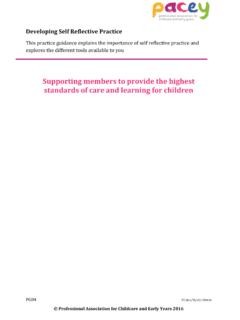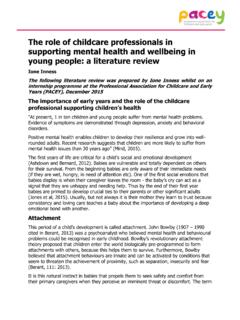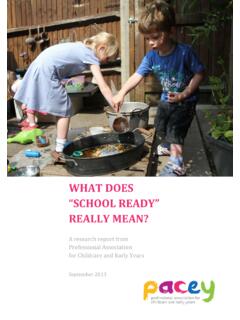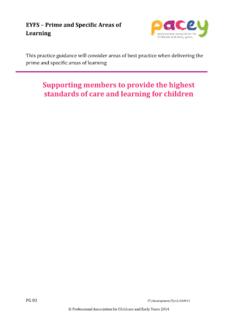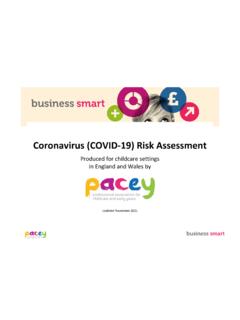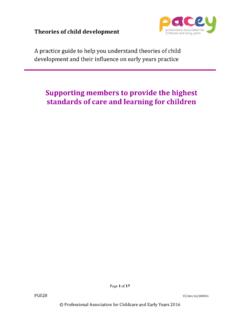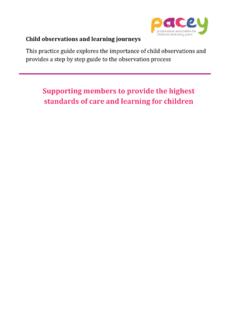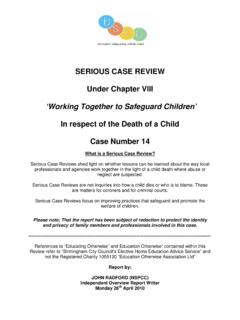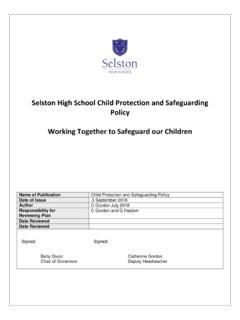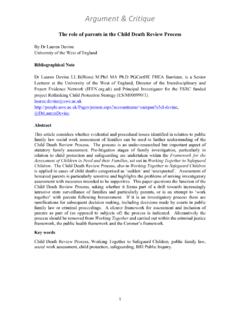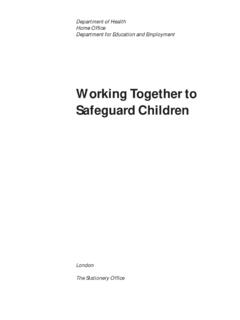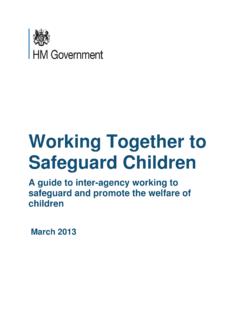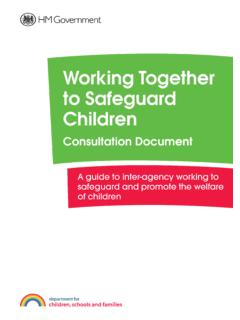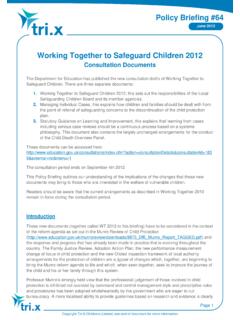Transcription of Working Together to Safeguard Children - Guide
1 Working Together to Safeguard Children A Guide to inter-agency Working to Safeguard and promote the welfare of Children April 2018 2 Contents Introduction 6 About this guidance 7 What is the status of this guidance? 7 Who is this guidance for? 8 A child-centred and co-ordinated approach to safeguarding 10 Key principles 10 Safeguarding is everyone s responsibility 10 A child-centred approach 12 Chapter 1: Assessing need and providing help 14 Early help 14 Identifying Children and families who would benefit from early help 14 Effective assessment of the need for early help 16 Provision of effective early help services 17 Accessing help and services 17 Referral 19 Information sharing 19 Assessments under the Children Act 1989 23 Statutory requirements 23 Assessment of disabled Children and their carers 24 Assessment of young carers 24 Assessment of young people in secure youth establishments 24 Contextual safeguarding 25 The principles and parameters of a good assessment 26 Assessment Framework 28 Focusing on the needs and views of the child 29 Developing a clear analysis 31 Focusing on outcomes 32 Timeliness 33 Local protocols for assessment 34 Processes for managing
2 Individual cases 35 3 Assessment of a child under the Children Act 1989 40 Strategy discussion 43 Initiating section 47 enquiries 47 Outcome of section 47 enquiries 49 Initial child protection conferences 51 The child protection plan 53 Child protection review conference 56 Discontinuing the Child Protection Plan 58 Chapter 2: Organisational responsibilities 61 Section 11 of the Children Act 2004 61 Individual organisational responsibilities 64 Schools and colleges 64 Early Years and Childcare 65 Clinical commissioning groups 66 Public Health England 67 Police 68 Adult social care services 69 Housing services 69 British Transport Police 70 Prison Service 70 Probation Service 71 The secure estate for Children 72 Youth Offending Teams 73 UK Visas and Immigration, Immigration Enforcement and the Border Force 73 Children and Family Court Advisory and Support Service 74 Armed Services 74 Multi-Agency Public Protection Arrangements 75 Voluntary and private sectors 75 Sports Clubs / Organisations 75 Faith Organisations 76 Chapter 3.
3 Multi-agency safeguarding arrangements 77 Safeguarding partners 77 4 Leadership 78 Publication of arrangements 79 Geographical area 80 Relevant agencies 80 Schools and other educational partners 81 Independent scrutiny 81 Funding 82 Dispute resolution 82 Updates to arrangements 82 Reporting 83 Information requests 83 Chapter 4: Learning from serious cases about Children 84 Overview 84 Principles for learning and improvement 85 Duty on local authorities to notify incidents to the Child Safeguarding Practice Review Panel 86 Guidance for safeguarding partners on serious child safeguarding cases 86 Action on receipt of a notification 86 Local child safeguarding practice reviews 87 Deciding when to carry out a local child safeguarding practice review 87 Other circumstances 89 Commissioning a reviewer or reviewers for a local child safeguarding practice review 89 Procedure for a local child safeguarding practice review 90 Expectations for the final report 91 Actions in response to national and local reviews 92 Guidance for the Child Safeguarding Practice Review Panel 92 Commissioning a reviewer for a
4 National child safeguarding practice review 94 Procedure for a national child safeguarding practice review 95 Expectations for the final report 96 Chapter 5: Child death reviews 98 Responsibilities of Child Death Review Partners 100 Child Death Overview Panels 101 5 Health input to child death review 103 Processes for notification 103 Responding to the death of a child 104 Involving and supporting the family 106 Appendix A: Glossary 108 Appendix B: Statutory framework 111 Children Act 2004 111 Education Acts 114 Children Act 1989 114 Provision of services for Children in need, their families and others 114 Co-operation between authorities 116 Emergency protection powers 118 Exclusion requirement 118 Police protection powers 119 Legal Aid, Sentencing and Punishment of Offenders Act 2012 119 Police Reform and Social Responsibility Act 2011 120 Childcare Act 2006 120 Crime and Disorder Act 1998 120 Housing Act 1996 120 Table A: Bodies and individuals covered by key duties 121 Appendix C.
5 Further sources of information 125 Supplementary guidance on particular safeguarding issues 125 Department for Education guidance 125 Guidance issued by other government departments and agencies 126 Guidance issued by external organisations 128 Supplementary guidance to support the Learning and Improvement Framework129 6 Introduction All Children have the right to a safe, loving, and stable childhood. Whilst it is parents and carers who have primary care for their Children , local authorities have overarching responsibility for safeguarding and promoting the welfare of all Children and young people in their area. They have a number of statutory functions under the 1989 and 2004 Children Acts, which make this clear, and this guidance sets these out in detail. Local authorities have specific duties in relation to Children in need and Children suffering, or likely to suffer, significant harm, regardless of where they are found, under sections 17 and 47 of the Children Act 1989.
6 The Director of Children s Services and Lead Member for Children s Services in local authorities are the key points of professional and political accountability, with responsibility for the effective delivery of these functions. Whilst local authorities play a lead role, safeguarding Children , promoting their welfare and protecting them from harm is everyone s responsibility. Everyone who comes into contact with Children and families has a role to Safeguarding and promoting the welfare of Children is defined for the purposes of this guidance as: protecting Children from maltreatment preventing impairment of Children 's health or development ensuring that Children grow up in circumstances consistent with the provision of safe and effective care taking action to enable all Children to have the best outcomes Local agencies, including the police and health services, also have a duty under section 11 of the Children Act 2004 to ensure that they consider the need to Safeguard and promote the welfare of Children when carrying out their functions.
7 Under section 10 of the same Act, similar ranges of agencies are required to co-operate with local authorities to promote the wellbeing of Children in each local authority area (see chapter 1). This co-operation should exist and be effective at all levels of the organisation, from strategic level through to operational delivery. Practitioners2 Working in agencies with these duties are responsible for ensuring that they fulfil their role and responsibilities in a manner consistent with the statutory duties of their employer. The 2017 Children and Social Work Act sets out how agencies must work Together by placing new duties on the police, clinical commissioning groups and the local authority to make arrangements to work Together and with other partners locally to Safeguard and promote the welfare of all Children in their area.
8 1 In this document, a child is defined as anyone who has not yet reached their 18th birthday. Children therefore means Children and young people throughout. 2 The term practitioners is used throughout the guidance to refer to individuals who work with Children and their families in any capacity. 7 About this guidance 1. This guidance covers: the legislative requirements and expectations on individual services to Safeguard and promote the welfare of Children a clear framework for the three local safeguarding partners (the local authority; a clinical commissioning group for an area within the local authority; and the chief officer of police for an area within the local authority area) to make arrangements to work Together to identify and respond to the needs of local Children 2.
9 This document replaces Working Together to Safeguard Children (2015). Links to relevant supplementary guidance that practitioners should consider alongside this guidance can be found at Appendix C. What is the status of this guidance? 3. This guidance applies to local authorities and all other organisations as set out in chapter 2. 4. It applies, in its entirety, to all schools. 5. This document should be complied with unless exceptional circumstances arise. 6. This guidance is issued under: section 7 of the Local Authority Social Services Act 1970, which requires local authorities in their social services functions to act under the general guidance of the Secretary of State section 10(8) of the Children Act 2004, which requires each person or body to which the section 10 duty applies to have regard to any guidance given to them by the Secretary of State section 11(4) of the Children Act 2004 which requires each person or body to which the section 11 duty applies to have regard to any guidance given to them by the Secretary of State section 16B(7)
10 Of the Children Act 2004, as amended by the Children and Social Work Act 2017, which states that the Child Safeguarding Practice Review Panel must have regard to any guidance given by the Secretary of State in connection with their functions 8 section 16C(2) of the Children Act 2004, as amended by the Children and Social Work Act 2017, which states that local authorities must have regard to any guidance given by the Secretary of State in connection with their functions relating to notifications section 16K of the Children Act 2004, as amended by the Children and Social Work Act 2017, which states that the safeguarding partners and relevant agencies for a local authority area in England must have regard to any guidance given by the Secretary of State in connection with their functions under sections 16E-16J of the Act section 16Q of the Children Act 2004, as amended by the Children and Social Work Act 2017.

